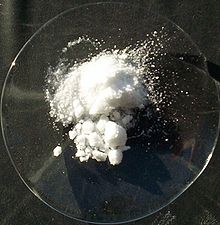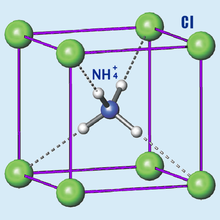This is an old revision of this page, as edited by EmausBot (talk | contribs) at 20:38, 11 February 2012 (r2.7.2+) (Robot: Adding my:ဇဝက်သာ). The present address (URL) is a permanent link to this revision, which may differ significantly from the current revision.
Revision as of 20:38, 11 February 2012 by EmausBot (talk | contribs) (r2.7.2+) (Robot: Adding my:ဇဝက်သာ)(diff) ← Previous revision | Latest revision (diff) | Newer revision → (diff) | ||||
 | ||||
| Names | ||||
|---|---|---|---|---|
| IUPAC name Ammonium chloride | ||||
| Other names Sal ammoniac, salmiac, nushadir salt, sal armagnac, salt armoniack | ||||
| Identifiers | ||||
| CAS Number | ||||
| 3D model (JSmol) | ||||
| ChEBI | ||||
| ChEMBL | ||||
| ChemSpider | ||||
| ECHA InfoCard | 100.031.976 | |||
| EC Number |
| |||
| KEGG | ||||
| RTECS number |
| |||
| UNII | ||||
| CompTox Dashboard (EPA) | ||||
InChI
| ||||
SMILES
| ||||
| Properties | ||||
| Chemical formula | NH4Cl | |||
| Molar mass | 53.491 g/mol | |||
| Appearance | White solid hygroscopic | |||
| Odor | odorless | |||
| Density | 1.5274 g/cm | |||
| Melting point | 338 °C (decomposes) | |||
| Solubility in water | 297 g/L (0 °C) 372 g/L (20 °C) 773 g/L (100 °C) | |||
| Solubility in alcohol | 6 g/L (19 °C) | |||
| Acidity (pKa) | 9.245 | |||
| Refractive index (nD) | 1.642 | |||
| Thermochemistry | ||||
| Std molar entropy (S298) |
94.85 J K mol | |||
| Std enthalpy of formation (ΔfH298) |
−314.55 kJ/mol | |||
| Hazards | ||||
| GHS labelling: | ||||
| Pictograms | class="wikitable collapsible" style="min-width: 50em;" | |||
| Pictogram | Code | Symbol description | Image link | |
 |
GHS01 | {{GHS exploding bomb}} | Image:GHS-pictogram-explos.svg | Explosive |
 |
GHS02 | {{GHS flame}} | Image:GHS-pictogram-flamme.svg | |
 |
GHS03 | {{GHS flame over circle}} | Image:GHS-pictogram-rondflam.svg | |
 |
GHS04 | {{GHS gas cylinder}} | Image:GHS-pictogram-bottle.svg | |
 |
GHS05 | {{GHS corrosion}} | Image:GHS-pictogram-acid.svg | Corrosive |
 |
GHS06 | {{GHS skull and crossbones}} | Image:GHS-pictogram-skull.svg | Accute Toxic |
 |
GHS07 | {{GHS exclamation mark}} | Image:GHS-pictogram-exclam.svg | Irritant |
 |
GHS08 | {{GHS health hazard}} | Image:GHS-pictogram-silhouette.svg | Health Hazard |
 |
GHS09 | {{GHS environment}} | Image:GHS-pictogram-pollu.svg | Environment |
See also
- {{H-phrases}}
- {{P-phrases}}
- Category:GHS templates
|-
|-
| style="padding-left:1em;" |
Hazard statements| H302, H319
|-
|-
| style="padding-left:1em;" |
Precautionary statements| P305+P351+P338
|- | NFPA 704 (fire diamond)
|

|- | Flash point | Non-flammable
|-
| colspan=2 style="text-align:left; background-color:#eaeaea;" | Lethal dose or concentration (LD, LC): |-
|-
| style="padding-left:1em;" |
LD50 (median dose)| 1650 mg/kg, oral (rat)
|-
|-
! colspan=2 style="background: #f8eaba; text-align: center;" |Related compounds
|-
|
Other anions| Ammonium fluoride
Ammonium bromide
Ammonium iodide
|-
|
Other cations| Sodium chloride
Potassium chloride
Hydroxylammonium chloride
|-
| colspan=2 style="text-align:left; background:#f8eaba; border:1px solid #a2a9b1;" |
Except where otherwise noted, data are given for materials in their standard state (at 25 °C , 100 kPa).|-
|}
Chemical compoundAmmonium chloride , an inorganic compound with the formula NH4Cl, is a white crystalline salt, highly soluble in water. Solutions of ammonium chloride are mildly acidic. Sal ammoniac is a name of the natural, mineralogical form of ammonium chloride. The mineral is especially common on burning coal dumps (formed by condensation of coal-derived gases), but also on some volcanoes. It is the product from the reaction of hydrochloric acid and ammonia.
Sources
It is a product of the Solvay process used to produce sodium carbonate.
- CO2 + 2 NH3 + 2 NaCl + H2O → 2 NH4Cl + Na2CO3
In addition to being the principal method for the manufacture of ammonium chloride, his method is used to minimize ammonia release in some industrial operations. Ammonium chloride is prepared commercially by combining ammonia (NH3) with either hydrogen chloride (gas) or hydrochloric acid (water solution):
- NH3 + HCl → NH4Cl
Ammonium chloride occurs naturally in volcanic regions, forming on volcanic rocks near fume-releasing vents (fumaroles). The crystals deposit directly from the gaseous state, and tend to be short-lived, as they dissolve easily in water.
Reactions
Ammonium chloride appears to sublime upon heating. However, this process is actually decomposition into ammonia and hydrogen chloride gas.
- NH4Cl → NH3 + HCl
Ammonium chloride reacts with a strong base, e.g. sodium hydroxide, to release ammonia gas:
- NH4Cl + NaOH → NH3 + NaCl + H2O
Similarly, ammonium chloride also reacts with alkali metal carbonates at elevated temperatures, giving ammonia and alkali metal chloride:
- 2 NH4Cl + Na2CO3 → 2 NaCl + CO2 + H2O + 2 NH3
A 5% by weight solution of ammonium chloride in water has a pH in the range 4.6 to 6.0.
Applications

The main application of ammonium chloride is as a nitrogen source in fertilizers, e.g. chloroammonium phosphate. The main crops are rice and wheat in Asia.
Pyrotechnics
Ammonium chloride is an ingredient in fireworks and safety and contact explosives.
Metalwork
Ammonium chloride is used as a flux in preparing metals to be tin coated, galvanized or soldered. It works as a flux by cleaning the surface of workpieces by reacting with the metal oxides at the surface to form a volatile metal chloride. For this purpose, it is sold in blocks at hardware stores for use in cleaning the tip of a soldering iron and can also be included in solder as flux.
Medicine
Ammonium chloride is used as an expectorant in cough medicine. Its expectorant action is caused by irritative action on the bronchial mucosa. This causes the production of excess respiratory tract fluid which presumably is easier to cough up. Ammonium salts are an irritant to the gastric mucosa and may induce nausea and vomiting.
Ammonium chloride is used as a systemic acidifying agent in treatment of severe metabolic alkalosis, in oral acid loading test to diagnose distal renal tubular acidosis, to maintain the urine at an acid pH in the treatment of some urinary-tract disorders.
Food
In several countries, ammonium chloride, known as sal ammoniac, is used as food additive under the E number E510, commonly as a yeast nutrient in breadmaking. It is a feed supplement for cattle and an ingredient in nutritive media for yeasts and many microorganisms.
Ammonium chloride is used to spice up dark sweets called salty liquorice, in baking to give cookies a very crisp texture, and in the flavouring Salmiakki Koskenkorva for vodkas. In India and Pakistan, it is used to improve the crispiness of snacks such as samosas and jalebi.
In the laboratory
Ammonium chloride is used to produce low temperatures in cooling baths. Ammonium chloride solutions with ammonia are used as buffer solutions.
Other applications
Ammonium chloride is used in a ~5% aqueous solution to work on oil wells with clay swelling problems. It is also used as electrolyte in zinc–carbon batteries. Other uses include in hair shampoo, in the glue that bonds plywood, and in cleaning products. In hair shampoo, it is used as a thickening agent in ammonium-based surfactant systems, such as ammonium lauryl sulfate. Ammonium chloride is used in the textile and leather industry in dyeing, tanning, textile printing and to luster cotton.
References
- ^ Solid state data from Ammonium chloride in Linstrom, Peter J.; Mallard, William G. (eds.); NIST Chemistry WebBook, NIST Standard Reference Database Number 69, National Institute of Standards and Technology, Gaithersburg (MD) (retrieved 2008-10-22)
- "Globally Harmonized System of Classification and Labelling of Chemicals" (pdf). 2021. Annex 3: Codification of Statements and Pictograms (pp 268–385).
- ^ Template:SigmaLink
- ^ Egon Wiberg, Arnold Frederick Holleman (2001) Inorganic Chemistry, Elsevier ISBN 0123526515, p. 614
- Rowley, Steven P. (2011). General Chemistry I Laboratory Manual (Second ed.). Kendall Hunt. ISBN 9780757589423.
- Dr. K. G. Bothara (7 October 2008). Inorganic Pharmaceutical Chemistry. Pragati Books Pvt. Ltd. pp. 13–. ISBN 978-81-85790-05-3. Retrieved 12 October 2011.
- Karl-Heinz Zapp "Ammonium Compounds" in Ullmann's Encylopedia of Industrial Chemistry 2012, Wiley-VCH, Weinheim. doi:10.1002/14356007.a02_243
| Urologicals, including antispasmodics (G04B) | |
|---|---|
| Acidifiers | |
| Urinary antispasmodics (primarily antimuscarinics) | |
| Other urologicals |
|